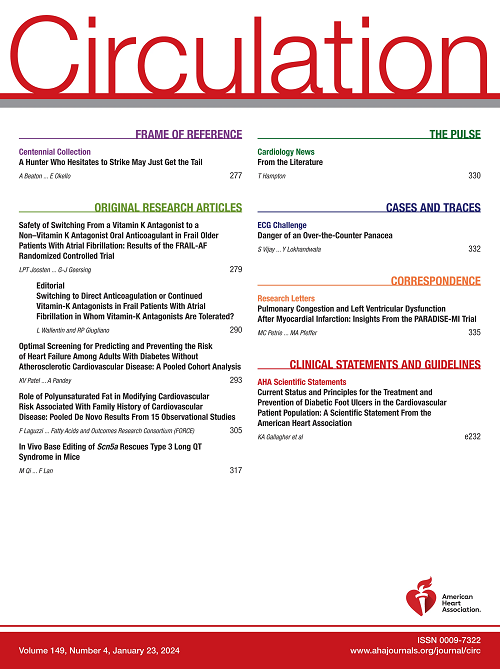Intracellular L-PGDS-Derived 15d-PGJ2 Inhibits CaMKII Through Lipoxidation to Alleviate Cardiac Ischemia/Reperfusion Injury.
IF 35.5
1区 医学
Q1 CARDIAC & CARDIOVASCULAR SYSTEMS
引用次数: 0
Abstract
BACKGROUND Myocardial ischemia/reperfusion (I/R) injury is a substantial challenge to the management of ischemic heart disease, the leading cause of mortality worldwide. Arachidonic acid (AA) is a prominent polyunsaturated fatty acid in the human body and plays an important role in various physiological and pathological conditions. AA metabolic enzymes determine AA levels; however, currently there is no comprehensive analysis of AA enzymes in cardiac I/R injury. METHODS The profiling of AA metabolic enzymes was analyzed with the RNA sequencing transcriptome data from the mouse heart tissues with I/R injury. Cultured neonatal and adult rat ventricular myocytes, human embryonic stem cell-derived cardiomyocytes, and in vivo mouse I/R models were used to confirm the role of L-PGDS (lipocalin-type prostaglandin D2 synthase)/15d-PGJ2 in I/R injury. A biotin-tagged 15d-PGJ2 analog combined with liquid chromatography-tandem mass spectrometry was used to identify the downstream signaling of L-PGDS/15d-PGJ2. RESULTS Based on the transcriptome data and experimental validations, L-PGDS, together with its downstream metabolite 15d-PGJ2, was downregulated in cardiac tissue with I/R injury. Functionally, L-PGDS overexpression mitigates myocardial I/R injury, whereas knockdown exacerbates the damage. Supplementation of 15d-PGJ2 alleviated I/R injury. Mechanistically, 15d-PGJ2 covalently bound to the Ca2+/CaMKII (calmodulin protein kinase II) and induced lipoxidation of its cysteine 495 (CaMKII-δ9) to dampen the formation of CaMKII oligomers and alleviate its overactivation, consequently ameliorating cardiomyocyte death and cardiac injury. CONCLUSIONS Our study uncovered L-PGDS/15d-PGJ2/CaMKII signaling as a new mechanism underlying I/R-induced cardiomyocyte death. This provides new mechanistic insights and therapeutic targets for myocardial I/R injury and subsequent heart failure. We also showed that lipoxidation is a new post-translational modification type for CaMKII, deepening our understanding of the regulation of its activity.细胞内l - pgds衍生的15d-PGJ2通过脂氧化抑制CaMKII减轻心脏缺血/再灌注损伤
背景心肌缺血/再灌注(I/R)损伤是缺血性心脏病治疗的重大挑战,缺血性心脏病是世界范围内死亡的主要原因。花生四烯酸(AA)是人体中一种重要的多不饱和脂肪酸,在各种生理和病理条件下起着重要作用。AA代谢酶决定AA水平;然而,目前还没有全面分析AA酶在心脏I/R损伤中的作用。方法利用I/R损伤小鼠心脏组织的RNA测序转录组数据分析AA代谢酶谱。利用培养的新生大鼠和成年大鼠心室肌细胞、人胚胎干细胞来源的心肌细胞和小鼠体内I/R模型,证实L-PGDS (lipocalin-type prostaglandin D2 synthase)/15d-PGJ2在I/R损伤中的作用。采用生物素标记的15d-PGJ2类似物结合液相色谱-串联质谱法鉴定L-PGDS/15d-PGJ2的下游信号通路。结果基于转录组数据和实验验证,L-PGDS及其下游代谢物15d-PGJ2在I/R损伤的心脏组织中下调。功能上,L-PGDS过表达可减轻心肌I/R损伤,而低表达可加重心肌I/R损伤。补充15d-PGJ2可减轻I/R损伤。在机制上,15d-PGJ2与Ca2+/CaMKII(钙调蛋白激酶II)共价结合,诱导其半胱氨酸495 (CaMKII-δ9)脂氧化,抑制CaMKII寡聚物的形成,减轻其过度激活,从而改善心肌细胞死亡和心脏损伤。结论我们的研究揭示了L-PGDS/15d-PGJ2/CaMKII信号通路是I/ r诱导心肌细胞死亡的新机制。这为心肌I/R损伤和随后的心力衰竭提供了新的机制见解和治疗靶点。我们还发现脂氧化是CaMKII的一种新的翻译后修饰类型,加深了我们对其活性调控的理解。
本文章由计算机程序翻译,如有差异,请以英文原文为准。
求助全文
约1分钟内获得全文
求助全文
来源期刊

Circulation
医学-外周血管病
CiteScore
45.70
自引率
2.10%
发文量
1473
审稿时长
2 months
期刊介绍:
Circulation is a platform that publishes a diverse range of content related to cardiovascular health and disease. This includes original research manuscripts, review articles, and other contributions spanning observational studies, clinical trials, epidemiology, health services, outcomes studies, and advancements in basic and translational research. The journal serves as a vital resource for professionals and researchers in the field of cardiovascular health, providing a comprehensive platform for disseminating knowledge and fostering advancements in the understanding and management of cardiovascular issues.
 求助内容:
求助内容: 应助结果提醒方式:
应助结果提醒方式:


